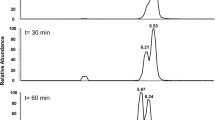Abstract
Evidence is presented for the existence in Pseudomonas putida of two NAD-linked dehydrogenases that function sequentially to oxidize benzyl alcohol. Induction of muconate lactonizing enzyme, a 3-oxoadipate pathway enzyme, indicated that P. putida oxidized benzyl alcohol to benzoate. Polyacrylamide gel electrophoresis with activity staining and enzymatic assays for an NAD-dependent dehydrogenase both showed that cells contained a single, constitutive alcohol dehydrogenase capable of oxidizing benzyl alcohol. This enzyme was shown to have the same specificity in extracts of glucose-grown as in benzy alcoholgrown cells. An NAD-aldehyde dehydrogenase oxidized benzaldehyde but was most active with normal alkyl aldehydes. This aldehyde dehydrogenase was shown to be induced, by enzymatic assays and by activity staining of polyacrylamide gel electropherograms, not only in cells grown on benzyl alcohol, but also in cells grown on ethanol. These experiments suggested that the aldehyde dehydrogenase was induced by the alcohol being oxidized rather than the substrate aldehyde.
In sum, the evidence from enzyme assays and polyacrylamide gel electrophoresis of extracts indicates that Pseudomonas putida catabolizes benzyl alcohol slowly when it is the sole carbon and energy source, by the action of a constitutive, nonspecific, alcohol dehydrogenase and an alcohol-induced, nonspecific aldehyde dehydrogenase to yield benzoate, which is further metabolized via the 3-oxoadipate (beta-ketoadipate) pathway.
Similar content being viewed by others
References
Beggs JD, Fewson CA (1974) Repression of the enzymes converting benzyl alcohol into benzoate in Acinetobacter calcoaceticus N.C.I.B. 8250. Biochem Soc Trans 2:924–925
Beggs JD, Fewson CA (1977) Regulation of synthesis of benzyl alcohol dehydrogenase in Acinetobacter calcoaceticus N.C.I.B. 8250. J Gen Microbiol 103:127–140
Beggs JD, Cook AM, Fewson CA (1976) Regulation of growth of Acinetobacter calcoaceticus N.C.I.B. 8250 on benzyl alcohol in batch culture. J Gen Microbiol 96:365–374
Clarke PH (1974) The evolution of enzymes for the utilization of novel substrates. Symp Soc Gen Microbiol 24:183–218
Cohen-Bazire G, Sistrom WR, Stanier RY (1957) Kinetic studies of pigment synthesis by non-sulfur purple bacteria. J Cellular Comp Physiol 49:25–68
Cook AM, Beggs JD, Fewson CA (1975) Regulation of growth of Acinetobacter calcoaceticus N.C.I.B. 8250 on L-mandelate in batch culture. J Gen Microbiol 91:325–337
den Dooren de Jong LE (1926) Bijdrage tot de kennis van het mineralsatieproces. Dissertation, Univ. Rotterdam
Dietz AA, Lubrano T (1967) Separation and quantitation of lactic dehydrogenase isoenzymes by disc electrophoresis. Anal Biochem 29:246–257
Gunsalus CF, Stanier RY, Gunsalus IC (1953) The enzymatic conversion of mandelic acid to benzoic acid. III. Fractionation and properties of the soluble enzymes. J Bacteriol 66:548–553
Halpin RA, Hegeman GD, Kenyon GL (1981) Carbon-13 nuclear magnetic resonance studies of mandelate metabolism in whole bacterial cells and in isolated, in vivo cross-linked enzyme complexes. Biochem J 20:1525–1533
Hegeman GD (1966a) Synthesis of the enzymes of the mandelate pathway by Pseudomonas putida. I. Synthesis of enzymes by the wild type. J Bacteriol 91:1140–1154
Hegeman GD (1966b) Synthesis of the enzymes of the mandelate pathway by Pseudomonas putida. II. Isolation and properties of blocked mutants. J Bacteriol 91:1155–1160
Hegeman GD (1966c) Synthesis of the enzymes of the mandelate pathway by Pseudomonas putida. III. Isolation and properties of constitutive mutants. J Bacteriol 91:1161–1167
Karlsson JL, Barker HA (1948) Evidence against the occurrence of a tricarboxylic acid cycle in Azotobacter agilis. J Biol Chem 175:913–921
Kennedy SIT, Fewson CA (1968a) Metabolism of mandelate and related compounds by bacterium N.C.I.B. 8250. J Gen Microbiol 53:259–273
Kennedy SIT, Fewson CA (1968b) Enzymes of the mandelate pathway in bacterium N.C.I.B. 8250. Biochem J 107:497–506
Laemmli UF (1970) Cleavage of structural proteins during the assembly of the head of bacteriophage T4. Nature 227: 680–685
Livingstone A, Fewson CA, Kennedy SIT, Zatman LJ (1972) Two benzaldehyde dehydrogenases in bacterium N.C.I.B. 8250. Distinguishing properties and regulation. Biochem J 130: 927–935
Mandelstam J, Jacoby GA (1965) Induction and multisensitive end-product repression in the enzymic pathway-degrading mandelate in Pseudomonas fluorescens. Biochem J 94:569–577
Moyes HM, Fewson CA (1976) Constitutivity of the mandelate enzymes in Acinetobacter calcoaceticus N.C.I.B. 8250 and its effect on the synthesis of benzyl alcohol dehydrogenase. Biochem Soc Trans 4:1105–1106
Ornston LN (1966) The conversion of catechol and protocatechuate to Beta-ketoadipate by Pseudomonas putida. IV. Regulation. J Biol Chem 241:3800–3810
Ornston LN, Stanier RY (1966) The conversion of catechol and protocatechuate to Beta-ketoadipate by Pseudomonas putida. J Biol Chem 241:3776–3786
Sistrom WR, Stanier RY (1954) The mechanism of formation of Beta-ketoadipate by bacteria. J Biol Chem 210:821–836
Stanier RY (1947) Simultaneous adaptation: a new technique for the study of metabolic pathways. J Bacteriol 54:339–348
Stanier RY (1950) Problems of bacterial oxidative metabolism. Bacteriol Rev 14:179–191
Stanier RY, Sleeper BP (1950) The bacterial oxidation of aromatic compounds. III. The preparation of enzymatically active dried cells and the influence thereon of prior patterns of adaptation. J Bacteriol 59:129–133
Suda M, Hayaishi O, Oda Y (1949) Studies on enzymatic adaptation. I. Successive adaptation, with special reference to the metabolism of tryptophan. Symp Enzyme Chemistry (Tokyo) 1:79–84
Weichselbaum TE (1946) Determination of proteins in blood serum and plasma. Am J Clin Path 16:40–49
Author information
Authors and Affiliations
Additional information
In memory of R. Y. Stanier
Rights and permissions
About this article
Cite this article
Collins, J., Hegeman, G. Benzyl alcohol metabolism by Pseudomonas putida: a paradox resolved. Arch. Microbiol. 138, 153–160 (1984). https://doi.org/10.1007/BF00413015
Received:
Accepted:
Issue Date:
DOI: https://doi.org/10.1007/BF00413015




